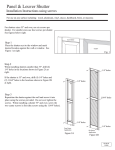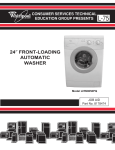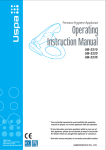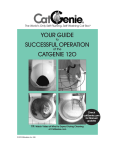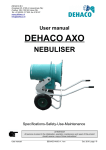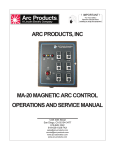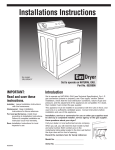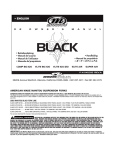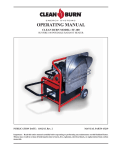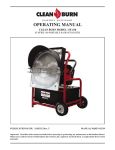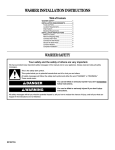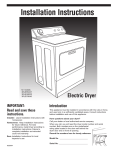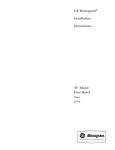Download Installation Instructions
Transcript
Installation Instructions Four-Wire Laundry System Washer•Dryer – 240 Volt IMPORTANT: Read and save these instructions. IMPORTANT: Installer: Leave Installation Instructions with the homeowner. Homeowner: Keep Installation Instructions for future reference. Save Installation Instructions for local electrical inspector’s use. Part No. 3405982 If washer/dryer does not operate... When moving the washer/dryer... If you need assistance... • Check that the circuit breaker is not tripped or the house fuse blown. • Check that power supply cord is plugged into wall receptacle. • Check that washer lid or dryer door is closed. • Check that the round shipping piece has been removed. • Check that controls are set in a running or “ON” position. • Check that dryer “START” button has been firmly pushed. • Disconnect the power supply cord. Tape power supply cord securely to washer/dryer. • Tape the dryer drum to the front panel. Tape the lint screen in place. Tape the dryer door closed. • Wedge a blanket between the tub ring and cabinet top to restrict tub movement. • Turn front leveling legs all the way in. Check your Use and Care Guide for a tollfree number to call, or call the dealer from whom you purchased this appliance. The dealer is listed in the Yellow Pages of your phone directory under ”Appliances — Household — Major — Service and Repair.” When you call, you will need the washer/ dryer model number and serial number. Both numbers can be found on the model/serial rating plate located behind the dryer door on the dryer door wall. Part No. 3405982 ©1996 Inglis Limited, 1901 Minnesota Court, Mississauga, Ontario L5N 3A7 Washers • Dryers • Refrigerators • Dishwashers • Waste Compactors • Microwave Ovens BRANCHES ACROSS CANADA Printed in U.S.A. Before you start... Check location where washer/dryer will be installed. Proper installation is your responsibility. The washer/dryer must not be installed or stored in an area where it will be exposed to water and/or weather. Make sure you have everything necessary for correct installation. Location should be large enough to fully open dryer door 90°. (See Panel E for “Recessed and closet installation instructions” and “Product dimensions.”) Important : Observe all governing codes and ordinances. Check code requirements. Some codes limit or do not permit the installation of washer/dryer in garages, closets, mobile homes and sleeping quarters. Contact your local building inspector. Grounded electrical outlet within (1.5m) 5 ft of the center rear of cabinet is required. See “Electrical requirements,” Panel A. Check utilities: Proper electrical supply must be available. See “Electrical requirements”, Panel A. Dryer may be exhausted from rear or left or right side. Exhausting through the side requires Side Exhaust Kit Part No. 279823. See “Exhaust requirements,” Panel B. Water heater: Set to deliver 60°C (140°F) water to the washer. Laundry tub drain system needs a 75.7 litres (16.7 Imperial gallons) laundry tub. Top of tub must be at least 71.1 cm (28 in) high and no higher than 121.9 cm (48 in) from floor. If a longer drain hose is needed, Drain Hose Part No. 388423, and Hose Connection Kit Part No. 285442, are available from your authorized parts distributor. Drain hose may also be installed to a laundry tub or floor drain system. See Panel D. Floor drain system requires a siphon break, Part No. 285320, available from your authorized parts distributor. Level floor: Maximum slope under washer/dryer, 2.5 cm (1 in). SEE RECESSED AND CLOSET INSTALLATION INSTRUCTIONS ON PANEL E . !! WARNING Tools and materials needed for installation: Phillips screwdriver pliers Fire Hazard Do Not use or store gasoline, paint, thinners and other flammable materials near washer/dryer. Fumes from such materials could result in fire or explosion. Never install washer/dryer up against draperies or curtains or on carpet. To do so may result in a fire. Keep any and all items from falling or collecting behind the washer/dryer. Failure to do so may result in a fire. Replace all access panels before operating washer/dryer. Do Not store or operate washer/dryer below 0°C (32°F) (some water may remain in washer). Proper operation of dryer cycles requires temperatures above 7°C (45°F). See Use & Care Guide for “Winterizing” information. Support: Floor must be sturdy enough to support washer/dryer weight with water and clothes of 170 kg (375 lb). utility knife For your safety, the information in this manual must be followed to minimize the risk of fire or explosion or to prevent property damage, personal injury or loss of life. Electric Shock Hazard It is the customer’s responsibility: To contact a qualified electrical installer. To assure that the electrical installation is adequate and in conformance with the Canadian Electrical Codes, and all local codes and ordinances. Failure to follow these instructions can result in death or electrical shock. Hot and cold water faucets must be within 1.2 meters (4 feet) of the back of the washer/dryer and provide water pressure of 34 to 690 kPa (5-100 psi). 10.2 cm (4 in) metal exhaust duct is required. Standpipe drain system needs a 5 cm (2 in) diameter standpipe with a minimum carryaway capacity of 64.4 litres (14.2 Imperial gallons) per minute. Top of standpipe must be at least 71.1 cm (28 in) high and no higher than 121.9 cm (48 in) from floor. !! WARNING duct tape safety glasses level gloves 1/4" socket wrench or nut driver slip-joint pliers that open to 3.8 cm (1-1/2") minimum OBSERVE ALL GOVERNING CODES AND ORDINANCES 1. A four-wire, single-phase, 120/240-volt, 60-Hz, AC only electrical supply is required on a separate 30-ampere circuit, fused on both sides of the line. (Time-delay fuse or circuit breaker is recommended.) 2. This washer/dryer is equipped with a fourwire, 30-amp rated flexible-type power supply cord. It must be plugged into a mating 30-amp receptacle (NEMA-type 14-30R). See Figure 1. Use 30-amp receptacle where local codes permit flexible-type supply cord (pigtail). G Electrical requirements !! WARNING Failure to follow these instructions may result in a fire. Y X W 14-30R 4-wire receptacle Figure 1 !! WARNING Electrical Shock Hazard Injury Hazard Electrical ground is required. More than one person is required to lift, tilt, or move this washer/dryer because of its weight and size. Do Not ground to a gas pipe. Failure to follow these instructions may result in injury. Improper connection of the equipmentgrounding conductor can result in a risk of electrical shock. Check with a qualified electrician if you are not sure this washer/dryer is properly grounded. Do Not change the power supply cord plug. If it will not fit the outlet, have a proper outlet installed by a qualified electrician. Do Not have a fuse in the neutral or grounding circuit. Do Not use an extension cord with this washer/dryer. Panel A Failure to follow these instructions could result in death or electrical shock. Exhaust requirements !! WARNING 0 1 Fire Hazard Do Not use non-metal, flexible duct. Do Not use metal duct smaller than 10.2 cm (4 in) in diameter. Do Not use exhaust hoods with magnetic latches. Check that exhaust system is not longer than specified. Exhaust systems longer than specified will: — Accumulate lint. — Shorten the life of the product. — Reduce performance and result in longer drying times and increased energy usage. Failure to follow specifications may result in a fire. Do Not exhaust the dryer into a chimney, furnace, cold air duct, attic or crawl space, or any other duct used for venting. Clean the exhaust system every year. Do Not install flexible duct under wall, ceiling or floor materials. Accumulated lint could be fuel for a fire or cause moisture damage. Exhausting your dryer indoors is Not recommended. The moisture and lint indoors may cause: — Lint to gather inside and around the dryer and be a fuel for fire. — Moisture damage to woodwork, furniture, paint, wallpaper, carpet, etc. — Housecleaning problems and possible health problems. Failure to follow these instructions could result in fire damage, injury or health problems. If using an existing exhaust system, clean lint from entire length of exhaust system. Make sure exhaust hood is not plugged with lint. The exhaust system should be inspected and cleaned yearly. Replace any vinyl or metallized plastic foil exhaust duct with rigid metal or flexible metal duct. Use duct tape to seal all joints. Do Not use screws to secure duct. exhaust air flow 10.2 cm (4 in) rigid metal pipe better is preferred. Plan installation to use the fewest number of elbows and turns. Maximum length of 10.2 cm (4 in) dia. duct NUMBER OF 90° TURNS good Metal flexible duct must be fully extended and supported when the dryer is in its final position. DO NOT KINK OR CRUSH THE DUCT. The metal flexible duct must be fully extended to allow adequate exhaust air to flow. Allow as much room as possible when using elbows or making turns. Bend duct gradually to avoid kinking. Remove excess flexible duct to avoid sagging and kinking that may result in reduced air flow. 2 3 0 1 2 3 10.2 cm (4 in) 10.2 cm (4 in) 6.4 cm (2-1/2 in) 13.1 m (43 ft) 10.1 m (33 ft) 7.0 m (23 ft) 5.5 m (18 ft.) 9.1 m (30 ft) 7.3 m (24 ft) 4.9 m (16 ft) 3.1 m (10 ft.) 12.5 m (41 ft) 9.5 m (31 ft) 6.4 m (21 ft) 5.5 m (18 ft.) 11.0 m (36 ft) 7.9 m (26 ft) 4.9 m (16 ft) 8.8 m (29 ft) 7.0 m (23 ft) 4.6 m (15 ft) 2.7 m (9 ft.) rigid metal duct With washer/dryer in laundry area. !! WARNING Injury Hazard More than one person is required to lift, tilt or move the washer/dryer because of its weight and size. Failure to follow this instruction may result in injury. Not recommended 7.3 m (24 ft) 5.5 m (18 ft) 3.1 m (10 ft) Now start... flexible metal duct Truck only from the rear to prevent product damage. Not recommended The maximum length using a 5.1 cm x 15.2 cm (2 in x 6 in) rectangular duct with 2 elbows and a 6.4 cm (2-1/2 in) exhaust hood is 2.4 m (8 ft). For exhaust configurations other than those listed in chart, the back pressure MUST not exceed 0.5 cm (0.2 inches) water column at the back of the washer/dryer. The back pressure should be checked by a qualified technician. For exhaust systems not covered by the exhaust length chart, see Service Manual, Part No. 603197, available from your authorized parts distributor. Service check: The back pressure in any exhaust system used must not exceed 0.5 cm (0.2 inches) of water column measured with an incline manometer at the point that the exhaust duct connects to the dryer. 1. Put on safety glasses and gloves. 2. Remove shipping cardboard base. rear legs • 4 legs • 1 drain hose front legs clamp • 1 plastic beaded strap • 4 flat, waterhose washers • 1 small clamp Exhausting the dryer outside is recommended. Recessed installation that is not exhausted outside must use Exhaust Deflector Kit Part No. 694609, available from your authorized parts distributor. See “Recessed and closet installation instructions,” Panel E, for unobstructed air opening requirements. If the washer/dryer is installed in a confined area such as a bedroom, bathroom or closet, it must be exhausted to the outside and provision must be made for enough air for combustion and ventilation. Check governing codes and ordinances. Also refer to the “Recessed and closet installation instructions” on Panel E. An exhaust hood should cap the exhaust duct to prevent exhausted air from returning into dryer. The outlet of the hood must be at least 30.5 cm (12 in) from the ground or any object that may be in the path of the exhaust. Remove parts from plastic package. Check that all parts were included. 4. Insert a rear-leveling 30.5 cm (12 in) leg into the hole in the rear minimum corner on the bottom of the washer/dryer. Push leg in until it snaps into place. Do the same same thing with the other leveling leg in the other rear corner. 10.2 cm (4 in) outlet hood is preferred. However, a 6.4 cm (2-1/2 in) outlet may be used with short systems only. A 6.4 cm (2-1/2 in) outlet can result in longer drying times than other hood types. For permanent installation, a stationary exhaust system is required. Exhausting the dryer through the side of the washer/dryer requires the use of Side Exhaust Kit Part No. 279823. Follow kit instructions for proper exhaust installation. 5. Push up one leg; check to see that the other leg goes down. Check the other leg the same way. (If legs do not adjust, repeat Step 4.) 6. Mobile home installation The exhaust duct can be routed up, down, left, right or straight out the back of the washer/ dryer. Space requirements are provided on Panel E and on the rear panel of the washer/dryer. Use the straightest path you can, to avoid 90˚ turns. 3. With one of the front legs in hand, check the ridges for a diamond marking. That's how far the leg is supposed to go into the hole. Start to screw the legs into the holes in the front corners by hand. outside wall skirting floor enclosed area Maximum length of the exhaust system depends upon the type of duct used, number of elbows and the type of exhaust hood. The maximum length for both rigid and flexible duct is shown in the chart. Panel B Mobile home exhaust requirements: The washer/dryer must have an outside exhaust. If the dryer is exhausted through the floor and the area under the mobile home is enclosed, the exhaust system must terminate outside the enclosed area. Extension beyond the enclosure will prevent lint and moisture buildup under the mobile home. Use slip-joint pliers to finish turning the front legs until you reach the diamond mark. Slide washer/dryer onto cardboard or hardboard before moving across floor to prevent damage to floor covering. Numbers correspond to steps. 7. Place a piece of cardboard or hardboard in front of carton. Now stand the washer/dryer upright. Slide washer/dryer onto cardboard or hardboard. 35. 9. 13. 10. 11. 12. To prevent product damage, do not remove corner posts before cutting. 11. 29. 9. 8. 9. With the corner posts in place, cut the carton down one corner. Remove carton. Do Not remove. 9. Remove the two rear corner posts located at the back of the washer/ dryer. Remove the two corner pieces attached to the lower front of the washer/dryer. Do Not remove the foam shipping pieces between the washer and dryer until the washer/dryer is in place. rear corner posts e ter ory Cen nmndr Ke Lau 13. Release washer lid by pushing up on latch. Close lid. lower front corner posts round shipping piece 11. Grasp round shipping piece at the front and the back. Lift to remove from inside washer. 10. latch Use new hoses and washers that came with your washer/dryer. 14. coupling washer Insert a flat washer into each end of the inlet hoses. Check that washers are firmly seated in couplings. latch Move foam shipping pieces outward just enough to clear the washer lid. Open the washer lid. The latch under the dryer will hold lid open. cold Inlet valves are plastic. Do Not strip or crossthread. 12. Take hoses out of basket. Place hoses with other parts. hot 15. Attach hose to bottom inlet valve opening first. Attach second hose to top inlet valve. Tighten couplings by hand; then use pliers to make an additional twothirds turn. IMPORTANT: THIS PROCEDURE MUST BE FOLLOWED TO ASSURE PROPER INSTALLATION. 0.64cm (1/4") max. clamp 8. drain connector 4. 5. 6. 16. 4. 5. 6. 7. Panel C Numbers correspond to steps. drain hose 0.64cm (1/4") max. To prevent the drain hose from coming off or leaking, it must be installed per the following instructions: 1. Wet the inside end of the drain hose with tap water. DO NOT USE ANY OTHER LUBRICANT. 2. Squeeze ears of small clamp with pliers to open clamp and place clamp over end of drain hose. 3. While holding clamp open, work end of drain hose onto drain connector until drain hose is within 0.64 cm (1/4 in) of ribbed stop. 4. Position clamp over the drain hose area marked “clamp.” Release clamp. Clamp should be 0.64 cm (1/4 in) from end of drain hose. 34. 35. 18. 24. 32. 26. 25. 22. 16. 15. Numbers correspond to steps. 23. 19. 14. 14. 17. 21. 33. 17. Slide washer/dryer onto cardboard or hardboard before moving across floor to avoid damaging floor. • Tilt the washer/dryer forward, raising back legs 2.5 cm (1 inch) off the floor so that the rear self-leveling legs will adjust. Gently lower the washer/dryer to the floor. • Check that the washer/dryer is level by placing a carpenter’s level on top of the washer, first side to side, then front to back. — If it is not level, adjust the front legs up or down. — Tilt the washer/dryer forward, raising back legs 2.5 cm (1 inch) off the floor so that the rear self-leveling legs will adjust. Gently lower the washer/dryer to the floor. — Check that the washer/dryer is level. Repeat as needed. 18. CHECK THAT DRAIN HOSE IS NOT TWISTED OR KINKED AND IS SECURELY IN PLACE. Standpipe or laundry tub drain system: Open hose clamp and slide over “hook” end of drain hose to secure the rigid and corrugated sections together. Floor drain system: Do Not install “hook” end of drain hose to corrugated section. Consult your plumber for proper installation. If you have room to work from either side of the washer/dryer, move washer/dryer close to final position so you can easily complete the installation steps. If you are working in a closet or recessed area, move the washer/dryer into its final position and remove cardboard/hardboard from under washer/dryer. Remove the two Phillips-head screws located at the top of the access panel. (See illustration for Step 24). Remove access panel and set access panel and screws aside. Complete the following steps through the access area. 20. Before attaching water inlet hoses, run water through both faucets into a bucket. This will get rid of any particles in water lines that might clog hoses. Mark which is the hot water faucet. 21. Attach bottom hose ( inlet marked “H”) to hot water faucet. Attach top hose (inlet marked “C”) to cold water faucet. Tighten the couplings to the faucets by hand. Use pliers to make the final two-thirds turn. Move washer/dryer to its permanent position. Remove cardboard/hardboard from under washer/dryer. 22. Panel D Carefully move the washer/dryer into final position. If you did not remove the access panel in Step 18, remove the two foam shipping pieces between the washer and dryer and place with the other shipping pieces. If the exhaust duct cannot be connected from the side of the washer/ dryer, the exhaust duct can be reached from the front through the access panel. Remove the two Phillips-head screws located at the top of the access panel.Set access panel and screws aside. 25. Determine the length of exhaust duct that is needed to connect the dryer to the exhaust hood. (See “Exhaust requirements,” Panel B). A plastic beaded strap plastic beaded strap B C 19. Put “hook” end of drain hose in laundry tub or standpipe. Check for proper length of drain hose. 24. 23. plastic beaded strap Make sure the “hook” end of drain hose is in laundry tub or standpipe. Wrap the plastic beaded strap around the drain hose and tub or standpipe. Thread beaded end of strap through keyhole end. Pull until strap is tight. Slide strap into narrow end of keyhole to lock strap in place. See Figures A-B. If the water inlet faucets and drain standpipe are recessed, tightly wrap the plastic beaded strap around the drain hose and faucet body. (Do Not wrap strap around the faucet handles or stems.) Thread beaded end of strap through keyhole end. Pull until strap is tight. Slide strap into narrow end of keyhole to lock strap in place. See Figure C. Secure the drain hose to the laundry tub or standpipe with the plastic strap. Failure to properly secure drain hose could result in water damage. 26. duct tape Connect exhaust duct to washer/dryer and then to the exhaust hood. • Use the straightest path possible to avoid 90° turns. • Use duct tape to seal all joints in the exhaust system. Do Not use screws. • Use caulking compound to seal exterior wall opening around exhaust hood. 27. CHECK ELECTRICAL REQUIREMENTS. BE SURE YOU HAVE CORRECT ELECTRICAL SUPPLY AND RECOMMENDED GROUNDING METHOD. Check the Installation Instructions to see that you have completed each step. Complete any missed steps before you continue. If drain hose cannot be strapped into place, hose must be cut exactly to length so “hook” end is held tightly over edge of laundry tub or standpipe. If a longer drain hose is needed, drain hose, Part No. 388423 and hose connection kit, Part No. 285442 are available from your authorized parts distributor. If drain hose must be shortened, use hose connection kit, Part No. 285442. Note: If washer/dryer is moved to adjust drain hose, the washer/dryer must be leveled again. Repeat Step 22. Place cardboard under the washer/dryer and carefully move washer/dryer to avoid damaging floor covering. 28. Check that all parts are now installed. See parts list, Panel B. If there is an extra part, go back through the steps to see which step was skipped. Recessed and closet installation instructions Product dimensions (Shown with legs extended 1 inch from bottom of washer/dryer.) 61 cm (24") !! WARNING 29. Check that you removed all the shipping pieces, including the round shipping piece. Dispose of all materials in proper manner. If you do not remove the round shipping piece, your washer/dryer may “walk” away from its location. Fire Hazard It is recommended that the washer/dryer be exhausted to the outside. If washer/dryer is installed in a closet, the dryer MUST be exhausted outside. Failure to follow these instructions may result in a fire. To prevent large amounts of lint and moisture from accumulating and to maintain drying efficiency, and to prevent exposure to possible health hazards, this appliance should be exhausted outdoors. THIS WASHER/DRYER MAY BE INSTALLED IN A RECESSED AREA OR CLOSET. 30. 31. Check that you have all your tools. Turn on water faucets and check for leaks. Tighten couplings if there is leaking. DO NOT OVERTIGHTEN. This could cause damage to faucets. 32. The installation spacing is in centimeters and inches and is the minimum allowable. Additional spacing should be considered for ease of installation, servicing and compliance with local codes and ordinances. If closet door is installed, the minimum unobstructed air openings in top and bottom are required. Louvered doors with equivalent air openings are acceptable. Closet installation must be exhausted. Other installations must use the minimum dimensions indicated. 33. 34. Read the Use and Care Guide to fully understand your new washer/dryer. Now start the washer and allow it to complete the regular cycle. dryer 48.3 cm (19") rear view 39.1 cm (15-3/8") side view 54.1 cm (21-5/16") 70.2 cm (27-5/8") 144.8 cm (57") 119.4 cm (47") 182.2 cm (71-3/4") 130.9 cm (51-1/2") 96.5 cm (38") 81.6 cm (32-1/8") washer front view side view Minimum installation spacing Note: If recessed installation is exhausted, all spacing can be 0 cm (0 in). Additional clearance for wall, door and floor molding may be required. 7.6 cm (3") 155 sq. cm (24 sq. in.) front view Unobstructed air openings are minimum for closet door. Louvered door with equivalent air openings is acceptable. Finally, save all literature and keep with washer/dryer. 0 cm (0") 310 sq. cm (48 sq. in.) You have just finished installing your new washer/dryer. To get the most efficient use from your new washer/dryer, read your Use & Care Guide. closet door Congratulations! 155 sq. cm (24 sq. in.) Panel E 36.2 cm (14-1/4") recess width 13.3 cm (5-1/4") 310 sq. cm (48 sq. in.) Keep Installation Instructions nearby where you can refer to them. They'll make reinstalling your washer/dryer in another home as easy as the first installation. 11.1 cm (4-3/8") recess depth 7.6 cm (3") 7.6 cm (3") 36. cold water inlet 72.7 cm (28-5/8") drain 69.9 cm (27-1/2") 0 cm (0") 30.5 cm (12") closet door 35. exhaust outlet 96.5 cm (38") Recessed installation Closet installation Remove tape from dryer door and open dryer door. Remove tape across the dryer lint screen. Check to be sure lint screen is in its proper position. Wipe out drum with a damp cloth to remove any dust. Start dryer and allow it to complete a heat cycle to make sure the dryer is working properly. 3.8 cm (1-1/2") 0 cm (0") Replace the access panel. Be sure to tighten screws at each end of the access panel. Plug power supply cord into grounded outlet. 30.5 cm (12") Additional space may be needed for exhaust 2.5 cm (1") side view Closet installation must be exhausted outdoors. Recessed, non-exhausted installation must use only the rear exhaust position and Exhaust Deflector Kit No. 4500 is required. 69.2 cm (27-1/4") Installation Instructions Four-Wire Laundry System Washer•Dryer – 240 Volt IMPORTANT: Read and save these instructions. IMPORTANT: Installer: Leave Installation Instructions with the homeowner. Homeowner: Keep Installation Instructions for future reference. Save Installation Instructions for local electrical inspector’s use. Part No. 3405982 If washer/dryer does not operate... When moving the washer/dryer... If you need assistance... • Check that the circuit breaker is not tripped or the house fuse blown. • Check that power supply cord is plugged into wall receptacle. • Check that washer lid or dryer door is closed. • Check that the round shipping piece has been removed. • Check that controls are set in a running or “ON” position. • Check that dryer “START” button has been firmly pushed. • Disconnect the power supply cord. Tape power supply cord securely to washer/dryer. • Tape the dryer drum to the front panel. Tape the lint screen in place. Tape the dryer door closed. • Wedge a blanket between the tub ring and cabinet top to restrict tub movement. • Turn front leveling legs all the way in. Check your Use and Care Guide for a tollfree number to call, or call the dealer from whom you purchased this appliance. The dealer is listed in the Yellow Pages of your phone directory under ”Appliances — Household — Major — Service and Repair.” When you call, you will need the washer/ dryer model number and serial number. Both numbers can be found on the model/serial rating plate located behind the dryer door on the dryer door wall. Part No. 3405982 ©1996 Inglis Limited, 1901 Minnesota Court, Mississauga, Ontario L5N 3A7 Washers • Dryers • Refrigerators • Dishwashers • Waste Compactors • Microwave Ovens BRANCHES ACROSS CANADA Printed in U.S.A.









